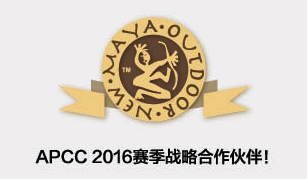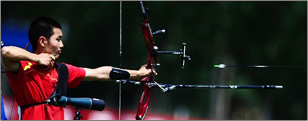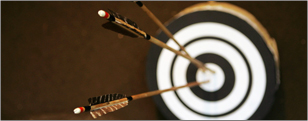




官方新浪微博扫一扫加关注

官方微信平台扫一扫加关注
Ⅰ The field of play shall comply with the following provisions:
1 The field of play shall be established with corners of 90 degree angles.
Each distance shall be accurately measured from a point vertically beneath the gold of each target face to the shooting line.
The tolerance of distance at 90/70/60m +- 30cm; at 50/40/30m course +- 15cm; at 25/18mcourse +- 10cm;
2 In the outdoor, it shall mark a waiting line behind the shooting line at least 30cm;
2 A waiting line shall be marked at least 5m behind the shooting line outdoors and at least 3m indoors.
3 Each target butt outdoors shall be set up at an angle of between 10 and 15 degrees from vertical and between 0 and 10 degrees indoors, but a line of target butts shall be set up all at the same angle.
4 The height of the centers of the target face in a line of the target butts shall look straight at all times.
5 All athletes in a category shall be assigned to one field of play.
6 Whenever possible, three athletes per target shall be assigned. If the field of play does not permit this, 4 athletes per target is the maximum number.
7 There shall be a mark on the shooting line directly opposite each target butt. There shall also be a number corresponding to that target butt between 1 and 2m in front of the shooting line. If two or more athletes are shooting at the same target butt at the same time, a target positions shall be marked on the shooting line. A minimum space of 80cm per athlete shall be guaranteed.
8 The field of play shall be divided into shooting lanes containing one to four butts. These lanes shall be marked by lines extending at right angles from the shooting line to the target line.
9 A line parallel to the shooting line shall be marked 3m in front of the shooting line.
10 Suitable barriers for public shall be erected to keep the spectators safe. Consideration shall be given to any distractions caused to the athletes by movement of people, etc. behind the butts.
Outdoors these barriers shall be at least 20m away from the side of the first target and the last target set at 90m. This distance may be reduced in in a straight line to a minimum of 10m away from the ends at the shooting line. This may maintain a margin of approximately 13m from the target line when the target butts are moved to 30m. The barriers shall be at least 10m behind the waiting line. The barriers shall be set up at least 50m beyond the 90m target line. This shall create a safety zone increasing to 110m when target butts have been moved forward to 30m. The safe distance of 50m may be reduced if an adequate backstop, e.g. efficient netting, a bank or similar device is erected (not a hedge or penetrable fence). The backstop shall be high enough to stop the arrows which just have missed the top of the butt at 90m.
Indoors where the size of the hall dictates, suitable barriers shall be erected around the range to keep spectators back. The barriers shall be at least 10m from the end of the target line and shall be at a minimum of 5m behind the waiting line. No spectators are allowed to beyond the target line. Where the size of the hall does not require the erection of size barriers no spectators are allowed to beyond the barriers situated behind the waiting line.
(see image 2: range layouts)
N (northern hemisphere)
1 shooting line 5 spectator barrier
2 waiting line 6 judges seats
3 equipment area 7 lights/digital clocks
4 competitor area 8 dos stand
image 2: range layouts
11 In the Elimination Round, target butts shall be arranged in closely set pairs.
12 For the elimination match round, the practice field shall be made available alongside the competition field, where the athletes still in the competition can practice during the elimination and final round.
13 For the team rounds, a clearly visible line shall be marked 1m behind the shooting line. The line shall be at least 3cm wide.
14 For the team rounds, there shall be an athlete’s area behind the 1m line, giving reasonable space for three athletes and their equipment and a coach’s area behind the athlete’s area. If space allows, there shall also be a small area marked for the judge between the two competing teams.
Ⅱ Venue equipment and scoring zones
1 Butts
The size of the front of the butt, whether round or square, shall be large enough to ensure that any arrows hitting the butt and just missing the outermost edge of the scoring zone remains in the butt. The arrows hitting shall remain embedded in the butt to allow proper scoring.
There are three kinds of target face:
The 122cm face, 122cm in diameter (all-round events);
The 80cm full face, 80cm in diameter (barebow 30m, conventional bow 30m);
The 80cm 6-ring target face (for multiple set-up with score zones 5-10) (recurve 30m, compound 50m)
The 60cm full face, 60cm in diameter (barebow, conventional bow);
40cm recurve with vertical triple face;
40cm compound with vertical triple face;
Remark: Only target face licensed by World Archery Federation or Chinese Archery Association and APCC shall be used at APCC federation round.
122cm, 80cm, 60cm and 40cm faces are divided into 5 concentric color zones arranged from the centres as follows: yellow, red, light blue, black and white. Each color is divided by a thin line into two zones of equal width thus making 10 scoring zones of equal width when measured from the centre of the gold:
6.1cm on the 122cm target face;
4cm on the 80cm target face;
3cm on the 60cm target face;
2cm on the 40cm target face;
Dividing ring line shall be entirely within the higher scoring zone in each case. There are no dividing lines between light blue and black, nor between black and white. The line marking the outermost edge of the white shall be made entirely within the scoring zone. The width of the thin dividing line and outermost line shall not exceed 2 mm on the target faces. The center of the target face shall be indicated by a small “+” (cross). The line of the cross shall not exceed 1mm in width or 4mm in length. An inner 10 ring, (which is marked as an X on the score cards) of 6.1cm in diameter for the 122cm target face and 4cm in diameter for the 80cm target face, is required to help determined ties in ranking. 20cm in diameters on the 40cm target face.
Outdoors the 80cm 6-ring target face may be used at 50m, 40m and 30m. The rings have the same dimensions as the 80cm faces. But with the 4-1 scoring zone removed. The lowest scoring zone is light blue 5.
Outdoors the 80cm 5-ring target face may be used 30m. The rings have the same dimensions as the 80cm faces. But with the 5-1 scoring zone removed. The lowest scoring zone is light blue 6.
Indoors triple faces may be used as follows: (For the indoor match round, 40cm triple faces shall be used. Vertical triple faces with recurve and compound are mandatory for the World Archery Indoor Championships). They hope the same dimension as World Archery 60cm and 40 cm respectively, but with the 5-1 scoring zones removed. The lowest scoring zone is therefore light blue 6. Each set consists of three small faces on a white background arranged symmetrically in a triangular pattern with the centres respectively bottom left, at the top, and at the bottom right, or in a vertical row. The centers of the golds shall be approximately 32cm distant from each other on 60cm faces and 22cm distant from each other on 40cm faces. There is a distinction between regular triple faces and recurve (R) and compound (C) 40cm triple faces. The 40cm triple face (both triangular and vertical) will differ in the size of the 10 ring: the 40cm-R has a 40mm 10 ring, the 40cm-C has a 20mm 10 ring and the combined triple face has the two 10-rings.
Outdoors the target faces shall be measured using the diameter of each separate circle enclosing each of the scoring zones. The tolerance of each diameter shall not exceed +- 1mm for the scoring zone 10, 9, 8 and hit zone and +- 2mm for the other scoring zones measured through the center.
Outdoors the target faces shall be measured using the diameter of each separate circle enclosing each of the 10 scoring zones. The tolerance of each diameter shall not exceed +- 1mm for the scoring zone 10, 9, 8 and hit zone and +- 2mm for the other scoring zones measured through the center.
For the Compound division only the inner 10-ring shall score 10, the rest of the yellow scoring zone shall score 9, providing that the Compound W1 Division, with athletes using recurve sights, will use the recurve 4cm 10-ring target face, see drawing (see image 5: 1-10 Soring zones target face.
The target face may be made of paper or any other suitable material. All faces used for the same competition category shall be uniform color and the same material.
The 122cm target face shall be used for the distance of 90, 70, 60m (and 50m for Cadet and Master Women). The 80cm target face shall be used for distances of 50, 40, 30m, except for the standard bow round.
The center of the single face or the center of the middle face of the vertical triple face shall be 130cm above the ground. When using the triangular triple face, the height refers to the two lower centres of the triple faces. When using a pair of faces, the minimum distance between scoring areas of the two faces shall be 10cm. When using the 60cm face, the minimum distance between scoring areas of the two faces shall be 2cm.
When using four 40cm faces, the maximum height of the center of the upper faces shall be 162cm above the ground, the minimum height of the center of the lower face shall be 100cm above the ground. When using the 40cm triangular triple face, the maximum height refers to the highest centre of the triple faces and the minimum height refers to the lowest centre of the triple faces. The minimum distance between the scoring areas of two faces at the same height shall be 10cm. Each face shall be placed in its quarter of the target (refer to the image7: 4×4 40cm indoor face and image 8: 4×4 indoor triangular triple face )
When using four 40cm vertical triple face, the centers of the middle target shall be 130cm above the ground.
With four vertical triple face, there shall be a space of at least 10cm between the scoring zone of the second and third column, and a maximum distance of 2cm between the scoring zones of column 1 and column 2, and column 3 and column 4.
When using 2 vertical triple face (individual and team round), there shall be a space of minimum 25cm between the scoring zone of each column.
Horizontally set up the one line vertical triple face (team shoot-off), the center of the middle target shall be 130cm above the ground.
4.1.4 The tolerance of the measurement shall not exceed +-2cm for the position of the target face.
5 Time control equipment
The director of shooting (see article 10.1.1) shall control:
5.1In the event of a small discrepancy between the audible and visual time control equipment, the visual time control equipment shall take precedence.
5.2 The following equipment can be used:
The colors of the lighst shall be red, yellow and green in that order with the red at the top. The light shall be synchronized and no time shall the different colors be on at the same time.
In championships, the light shall be linked with the audible control equipment, so that the first sound of the audible equipment is simultaneous with the light turning red and the digital clock reaching zero.
6 Other equipment
The equipment outlined in the bylaw below is mandatory at international events and is
6.1 Athletes’ number shall be worn by each athlete.
6.2 A device to indicate the order of shooting if the athletes do not all shoot at the same time. The letters shall be large enough to be read by all athletes from their respective shooting positions.
6.3 A scoreboard for accumulative totals after each group, for at least first five athletes of each category and the scores for qualification cut.
6.4 In the Olympics round, compound and indoor match play, the brand shall be placed front of the shooting line to indicate the same of the number of the athlete and the family name. If there is a discrepancy, the electrical name or the acronym of the official team English name take precedence.
6.5 In the elimination round, a flip-score device to show three digitals shall be displayed under the butt.
6.6 In the final rounds, there shall be a remotely-operated scoreboard for athlete or team, with spaces for the scores of three individual arrows and the total score or set for each match. There shall also be provision for the athlete’s name and country, or the country in the team competition.
6.7 Blinds for use in the final rounds may be placed near the butt. They shall be used by judges, athletes agents and scorers.
6.8 Outdoors wind flags, of any light material and easily visual color (such as yellow) to serve as the wind indicators, shall be place above the center of each target. They shall be placed 40cm above the butt or the target number, whichever is higher. They shall measure not more than 30cm and not less than 25cm in any dimension.
6.9 outdoors wingsacks on the both sides of the field and one in the middle when there is a split between the two sides. Windsacks shall be between 2.5 and 3.5m above the ground.
6.10 A raised platform with seating facilities for director of shooting.
6.11 audible system and wireless radio
6.12 On the shooting field other than the final field and the final area of the main field, a sufficient number of chairs and benches shall be placed behind the waiting line for all athletes, team manager, coaches and other officials.
At the qualification and elimination field, the chairs and shelters shall be placed along the suitable position for judges.
6.13 the automatic scoring system may only use for the final.
6.14 A small diameter television camera may be placed on the center of the target face other than when a shoot-off is occurring.